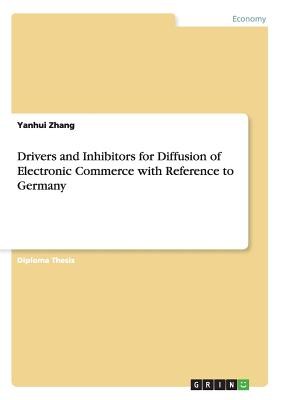
- We will send in 10–14 business days.
- Author: Yanhui Zhang
- Publisher: GRIN Verlag
- Year: 2007
- Pages: 104
- ISBN-10: 3638736563
- ISBN-13: 9783638736565
- Format: 14.8 x 21 x 0.6 cm, softcover
- Language: English
- SAVE -10% with code: EXTRA
Drivers and Inhibitors for Diffusion of Electronic Commerce with Reference to Germany (e-book) (used book) | bookbook.eu
Reviews
Description
Diploma Thesis from the year 2004 in the subject Business economics - Offline Marketing and Online Marketing, grade: 1,3, University of Northampton, language: English, abstract: CHAPTER ONE INTRODUCTION Information services and products today constitute one of the world's largest economic sectors. Computers and the networks that connect them have become a dominant force in virtually all aspects of society throughout the industrialized world. Institutions and individuals alike are flocking to the Internet - particularly to the World Wide Web - in record numbers, making it the fastest-growing medium in human history (Baptista, 2000). First made available to the public in 1992, the Web is used today by 205 countries and regions and its user number is expanding at approximately 30 percent per year (OECD, 2002). Technological improvement as well as the declining prices for the access of this technology has led to the explosive growth of Internet during the last few years. The electronic commerce (e-commerce), as one of the most important applications of the Internet technology, is undoubtedly bringing countries together to create a global network economy with expectation of reducing transition costs, increasing market transparency and making business more efficient. However, e-commerce is unevenly diffused in different countries. New growth theory (Ohmae (1996); Solomon & Bamossy (2002) insists that national characteristics such as industry structure, information infrastructure, financial systems and national policies, influence technology diffusion and innovation outcomes unevenly. E-commerce via Internet is said to have no national borders, however, individuals and companies in different countries response differently to it. Hence, understanding adoption drivers and inhibitors of e-commerce diffusion is becoming increasingly important. [...]
EXTRA 10 % discount with code: EXTRA
The promotion ends in 5d.05:57:02
The discount code is valid when purchasing from 10 €. Discounts do not stack.
- Author: Yanhui Zhang
- Publisher: GRIN Verlag
- Year: 2007
- Pages: 104
- ISBN-10: 3638736563
- ISBN-13: 9783638736565
- Format: 14.8 x 21 x 0.6 cm, softcover
- Language: English English
Diploma Thesis from the year 2004 in the subject Business economics - Offline Marketing and Online Marketing, grade: 1,3, University of Northampton, language: English, abstract: CHAPTER ONE INTRODUCTION Information services and products today constitute one of the world's largest economic sectors. Computers and the networks that connect them have become a dominant force in virtually all aspects of society throughout the industrialized world. Institutions and individuals alike are flocking to the Internet - particularly to the World Wide Web - in record numbers, making it the fastest-growing medium in human history (Baptista, 2000). First made available to the public in 1992, the Web is used today by 205 countries and regions and its user number is expanding at approximately 30 percent per year (OECD, 2002). Technological improvement as well as the declining prices for the access of this technology has led to the explosive growth of Internet during the last few years. The electronic commerce (e-commerce), as one of the most important applications of the Internet technology, is undoubtedly bringing countries together to create a global network economy with expectation of reducing transition costs, increasing market transparency and making business more efficient. However, e-commerce is unevenly diffused in different countries. New growth theory (Ohmae (1996); Solomon & Bamossy (2002) insists that national characteristics such as industry structure, information infrastructure, financial systems and national policies, influence technology diffusion and innovation outcomes unevenly. E-commerce via Internet is said to have no national borders, however, individuals and companies in different countries response differently to it. Hence, understanding adoption drivers and inhibitors of e-commerce diffusion is becoming increasingly important. [...]


Reviews